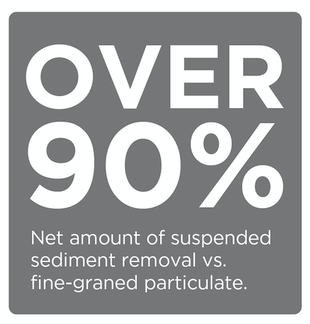 There are clear impacts of failed stormwater management programs – erosion, polluted waterways and even damage to drinking water. For some projects, a single solution is not enough to protect sensitive waterways from runoff. The treatment train approach is an increasingly important management tool engineers can consider for challenging projects. So what exactly is a treatment train system? According to a report from Ecological Engineering, it is a model that is “capable of predicting the performance of stormwater wetlands, ponds, vegetated swales, sediment basins and biofilters, with a single algorithm. The model describes two principal processes: (a) water quality behavior and (b) hydrodynamic behavior.”[i] To put it simply, it’s creating a stormwater management plan with a series of BMPs that often combines natural treatment (such as a pond or grass filter) with a manufactured treatment device using hydrodynamic separation (such as the Aqua-Swirl). When should this model be considered? The treatment train model for stormwater management should be considered when sensitive water is at risk. According to the EPA, “Sand and organic filters are typically used as the second downstream component of a treatment train to remove pollution from stormwater before discharge to receiving waters, to groundwater, or for collection and reuse.”[ii] Hydrodynamic separation provides the upstream pretreatment component of the treatment train. Can a treatment train be considered if a pond or grass filter isn’t an option due to location / space? Yes! Significant operational and performance benefits can be realized through the use of the treatment train design that is incorporated into the Aqua-FilterTM Stormwater Filtration System as documented by long-term independent field-testing of a system. This included the Aqua-Swirl hydrodynamic separator as the upstream (pretreatment) component followed by a filtration chamber as the downstream (secondary) component. The Aqua-Swirl is designed to remove sediment, debris, floatables and free-floating oil, while the filtration chamber refines and polishes the stormwater quality prior to discharge by removing fine-grained particles. Over 90% of suspended sediment removal is provided by the Aqua-Filter on a net annual basis against fine-grained particulate. The treatment train serves to provide exceptional sediment removal including the fine-grained particulate at a loading rate up to 21 gpm/ft2. Benefits Achieved: The Aqua-Filter system design provides the following benefits for the treatment of stormwater runoff as opposed to filtration systems that rely solely on filtration and do not incorporate pretreatment:
See a complete breakdown of the outcomes in our Tech Report. Not sure if a Treatment Train could work for you? Register for our FREE stormwater consultation to discuss the technicalities of your treatment plan. [i] “Modelling Urban Stormwater Treatment – A Unified Approach.” Tony H.F. Wong, Tim D. Fletcher, Hugh P. Duncah. http://www.researchgate.net/publication/22242979 [ii] “Stormwater Management Best Practices” EPB.gov. http://www.epa.gov/greeningepa/stormwater/best_practices.htm
1 Comment
|
AuthorAquaShield staff keeping you up to date on the latest in stormwater solutions. Archives
December 2015
Categories
All
|
|
AquaShield, a Komline Company
2733 Kanasita Drive, Suite 111 Chattanooga, TN 37343 Toll Free: 888.344.9044 | Phone: 423.870.8888 © 2000-2024 AquaShield™. All Rights Reserved. |
VISION STATEMENT
To be the vanguard for providing technology that gives higher quality usable water to every country and community that needs it.


 RSS Feed
RSS Feed